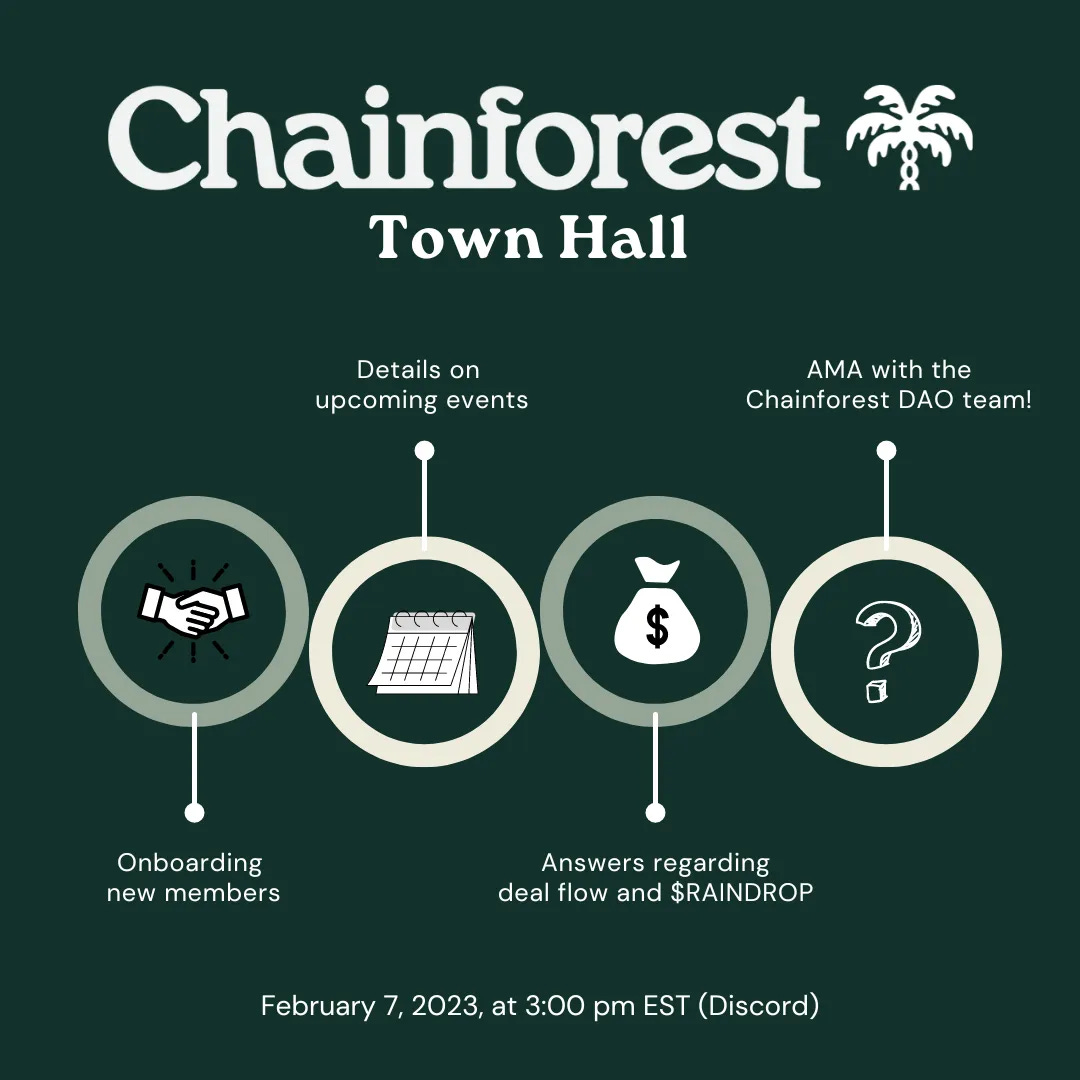Greetings Rainmakers! ⛓️🌴
Welcome to the latest edition of the Chainforest Weekly Recap, where you’ll find up-to-date information on upcoming Chainforest DAO programming and industry events, the community feature of the month, a round-up of the most exciting happenings in our Discord this week, and a welcome to our new Rainmaker’s!
In the past week, 3 new Rainmakers have joined the forest!
The top three channels were: 💬│general-chat, 💞│wtf, and 💰│real-world-assets.
Upcoming Chainforest Programming ⛓️🌴
Monthly Town Hall: We will be sharing the latest happenings/updates at Chainforest DAO, onboarding new members, along with having a Q&A session for all members! This event is open to all members! If you are a new member of Chainforest DAO, please stop by and introduce yourself to the community!
When: February 7, at 3:00 pm EST in our Discord
RSVP: here
Women in The Forest NYC Breakfast:
When: January 31, in New York City
For more details: click here
Previous Events & Recordings
Chainforest Web3 Dinner in San Francisco
On January 24th, Chainforest curated a group of thoughtful and supportive web3 leaders for a conversation that gives each of us (1) a clearer sense of where to allocate our resources in 2023 and (2) a community of like-minded people in the Bay Area
Monthly Town Hall (January 2023): Did you miss our December Town Hall meeting? Check it out here!
Covered during the Town Hall:
Rainmakers shared their thoughts on the crypto sentiment heading into 2023
Members discussed where they are currently spending the majority of their time and energy in the space
Junney asks what are Rainmaker’s views on the end result of how many wallets and what types of solutions will take the majority of the market share
Chainforest will be sharing its next community discussion theme soon!
To view the entire duration of the Town Hall, download the file.
Twitter Space: A discussion with Jason Badeaux, Co-Founder of React Networks, on Decentralized Energy! (listen here)
Panel: Amit Mukherjee, Nick van der Vick, & Jason Badeaux
Discord Highlights 👀
Jason Badeaux (Co-founder of React Networks) joins the community and answers questions regarding decentralized energy! 🔋
Michael asks Jason about his approach toward building API usage demand amongst utility providers:
Jason: We expect API usage will be driven by a number of opportunities
VPP operators utilizing the network’s energy management system (DERMS)
Measurement and verification of VPP dispatch/response/settlement with real-time data (critically important)
Utilities looking for better distribution management data (real-time outages, power quality, etc)
ISOs/utilities looking for better data to improve forecasting and reduce forecasting errors
Fire insurance! This is underappreciated but electrical issues are massive contributors to property fires, and voltage monitoring is a great way to improve underwriting / prevent fires
Retail electricity providers procuring better quality / cheaper data (in deregulated markets)
Solar/DER/energy efficiency companies looking for leads and feasibility studies
Utilities are tough enterprise customers, so I expect they’ll come later in the adoption cycle than some of these other opportunities. The REP and VPP angle are the largest early markets
Ian notes that despite a push towards Real World Assets (RWAs) and away from Digitally Native Assets (DNAs) in a bear market, each bull market is driven by DNAs (BTC, ETH, Governance Tokens, NFTs). This cycle will be no different 💰
Amit follows up with two questions: 1) Does this mean you're more bullish on digitally native assets? Do you believe governance tokens should carry real market value the way they do now? 2) Could this cycle be different given how much more developer activity can occur on ETH and other L1s versus prior cycles?
1) Yes. Bullish DNAs, bearish RWAs. RWAs require centralization and oracles, which are fine, but bearish that they are the thing that will drive the next bull market and wave of innovation. tokenizing real-world assets like a house or mortgage is conceptually interesting, but they can't take advantage of web3/crypto tech, in the same way, DNAs can because composability is most valuable when the assets are 100% trustlessly guaranteed, which RWAs are not
2) Compared to 2018, a lot has changed from an L1, DeFi, and tech perspective, but IMO not in terms of RWA or their value. I do believe RWAs will be a thing, but more like 5-15+ years, and the risk is that they all are permissioned and web2-like businesses with pretty boring businesses/models. I think if you can be like Circle and have a dominant position on a particular RWA with lots of liquidity and volume (USDC) and monetize it, great, but there are few things like that (most are NFTs) and have that kind of potential. plus, from an investing perspective, far more attractive I think to invest in a startup built on an RWA with wide adoption like USDC than a startup creating an RWA or building something that depends on RWAs to be adopted at scale
Amit shares a few additional thoughts on Real World Assets 💵
1) A lot of the success cases in web3 RWAs are red herrings: The crypto community is so eager to claim victories that we often point to examples of victories that fail to pass muster on closer examination. Axie Infinity is the best example of this - where many people claimed that the game was changing the Filipino economy. In the case of RWAs, people often point to the $100M BlockTower facility, KKR's tokenized fund, and Maker DAO's debt deal with BVH
2) A lot of commentators are muddling the "hair on fire" problem that crypto solves: There are 3 purported technological advantages of crypto for RWAs
a. Cutting out middlemen: A lot of analysts point to the various service providers that are cut out of the process. Kevin Miao shared this graphic with about a dozen different service providers, whose total cost in a transaction typically adds up to 1%. I believe he means 1% interest cost. If loan interest rates are anywhere from 4-10% these days, 1% is a lot! It also adds a lot of time and effort. So reducing these would reduce transaction costs
b. Increasing transparency: Another purported benefit is greater transparency. That you'd be able to see all the underlying cash flows associated with a security. And over time, if your loans were against a basket of assets, you could see how each is performing in real-time, and this would also help segment out loans to different risk levels
c. Increased DEMAND: Finally, enthusiasts point to greater demand being created by things being tokens. That more people in the world will be able to access these investment opportunities, which will create greater liquidity and drive down the price
Amit highlights The Bulletin Board System Network, BBS! ⭐
As shared in LionTree’s crypto newsletters, BBS is a decentralized network of user-owned message boards. Similar to the popular site, Reddit, BBS allows users to create a board on any subject and operate it on their own accord. The system gives users the ability to take control of their own content policies and revenue sharing between members – yes, revenue-sharing
Rainmakers note that what BBS describes in their mission sounds a lot like Token Curated Registries (TCR)
DA0uch notes that what he loves most about BBS’s product is the ability for newsletter subscribers to earn a % of advertising revenue. This one feature will help their user acquisition efforts for sure. Will all depend on how much demand there is for BBS’s advertising packages for this to be a powerful incentive for readers to join the network
Rainmakers continue to discuss why HNT is not considered a security when he receives HNT for deploying a hotspot. 📱
Nick adds that Amira’s response covers a lot of the policy side. For projects (e.g. HNT, PCN, there are additional ways networks have tried to avoid asset classification. For example, the PCN whitepaper explains a potential PCN peg mechanism as a .10c data credit. There is a distinction when payments or comp comes in a non-native form of comp (think airline miles/rewards points)
Devalpha writes, to pass the Howey test there needs to be evidence that someone is buying something from which they can reasonably expect to profit, based on the efforts of others (common enterprise). The purpose of HNT can be argued to be similar to a token one would buy at an arcade in order to use the arcade's services ... that token allows you to ride the rides (use HNT's network) ... but you aren't buying the token because you expect to derive profits... If Helium were to incorporate some type of buyback mechanism, or revenue share, into HNT, then one could make the argument that profits should be expected when buying HNT. At that point, the common enterprise criteria would come into play, and assuming that is satisfied, HNT would arguably be considered a security
Amit responds that he thinks what confuses this is that Helium puts buy pressure on HNT in a two-token system. In order to buy the wireless coverage, you need to buy HNT and burn it to buy another token. So investors could credibly hold HNT in order to see some price increase
Upcoming Events 🗓️
ETH Denver - Welcome to the largest and longest-running ETH event in the world! ETHDenver is a community-owned innovation festival.
Community Feature of the Month🎉
Our Community Feature of the Month is Devin Becker (Game Design/Web3 Economy Consultant, Gaming Lead at Nami)!
New Members 🎊
Reffo Tse | ECHO
Slater Heil | Blueberry Protocol
Luke Katz | Serotonin
Interested in joining Chainforest? ⛓️🌴
How to apply: You can apply to become a member by completing our application on Typeform. We will review your submission and grant access after approving your profile.
Apply here: https://chainforest.typeform.com/apply
I hope you enjoyed this week’s edition of the Chainforest Weekly Recap!
Till next week,
Sloan (@sloan0_0)










